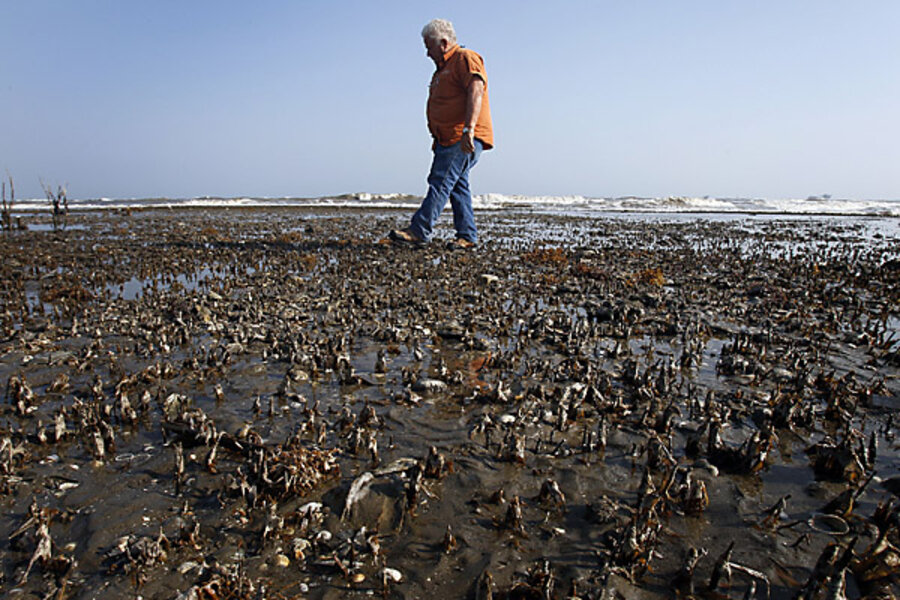BP to inject $1 billion into Gulf restoration
Loading...
NEW ORLEANS (AP) — Energy giant BP agreed Thursday to spend $1 billion this year for an array of cleanup projects in the Gulf of Mexico, bidding to speed environmental recovery from last year's massive oil spill while paring down its own liability for the nation's largest offshore oil spill.
The agreement between BP, the federal government and the five Gulf states oiled by the spill sets into motion years of work restoring natural resources. BP and the other companies involved in the 206-million-gallon spill face billions of dollars in fines for long-term restoration.
"This milestone agreement will allow us to jump-start restoration," Interior Secretary Ken Salazar said.
The Justice Department said the agreement does not affect the potential legal liability that BP and other companies may face from lawsuits for damages resulting from the spill, which began after the Deepwater Horizon rig off Louisiana exploded on April 20, 2010.
The money is expected to fund an array of restoration projects — which could be as diverse as building fishing piers, building new oyster reefs, or stabilizing bird sanctuaries with rock barriers — all to be chosen after public review. Those projects are to be selected by a trustee council, a federal-state body set up to safeguard the public's resources and oversee the oil spill restoration.
An upfront payment of this kind is not required under the Oil Pollution Act, the nation's oil spill law. Still, by paying such an amount for restoration now BP would be expected to pay less at a final settlement.
Lamar McKay, the chairman and president of BP America Inc., said the agreement "is the best way to get restoration projects moving as soon as possible."
Under the agreement, the five Gulf states get $100 million each and the federal government will get $200 million. The remaining $300 million will be divvied out to projects deemed the most urgent.
The $1 billion is a kind of ante on the eventual cleanup bill and helps all the parties control the cost of the spill.
"It provides some resources early rather than wait for the many years it could take for the natural resource damage assessment process could play out," said Donald Boesch, a University of Maryland oceanographer who sat on a presidential commission that investigated the spill.
After a spill, an in-depth damage assessment determines how much a polluter should pay. For a spill of such magnitude, it could take several years, even a decade or more, before a final settlement on damages is reached.
"This is a down payment and we expect more of these in the future," said Garret Graves, Louisiana Gov. Bobby Jindal's top aide on coastal affairs. "This represents a fraction of the total impact to our coastal area."
Boesch, a veteran of the Exxon Valdez restoration, said he hoped the money would be spent with the good of the overall ecosystem in mind. He anticipated a certain amount of discussion before projects are approved and encourage a "sound scientific review process" for best uses of the funds.
In Alaska after the Exxon Valdez accident, he said government agencies often settled for compromises. "It was this kind of situation where they all came to the table but each had a self-interest."
State and federal officials said Thursday that they had not developed short lists for their restoration plans.
But they have talked about a variety of possible fixes. Those include building new oyster reefs, nourishing tar-littered beaches and planting marshes and wetlands from Texas to Florida. Also, officials are interested in replenishing fish stocks with hatcheries and embellishing public land fouled by the black tide of oil and the months-long cleanup that continues one year later.
Louisiana's oystermen are those most in need of urgent action. Oyster production is down by half after last year's spill and the industry faces serious problems if reef work does not proceed soon.
"We have missed the spring spawning season; we're hopeful that we can get things in place to bid out some of this rehabilitation money for the fall cycle" of oysters, said John Tesvich, an industry leader with the Louisiana Oyster Task Force.





